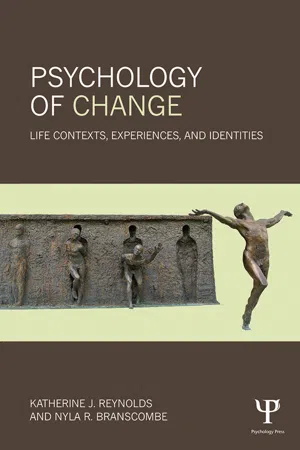Psychology
Trait Theory of Personality
The Trait Theory of Personality suggests that individuals possess certain enduring characteristics, or traits, that influence their behavior, thoughts, and emotions. These traits are relatively stable over time and across different situations, and they can be used to describe and predict an individual's behavior. Trait theory focuses on identifying and measuring these consistent patterns of behavior to understand and explain personality.
Written by Perlego with AI-assistance
Related key terms
10 Key excerpts on "Trait Theory of Personality"
- eBook - ePub
Personality Theories
Critical Perspectives
- Albert Ellis, Mike Abrams, Lidia Dengelegi Abrams(Authors)
- 2008(Publication Date)
- SAGE Publications, Inc(Publisher)
Chapter 9Personality and Traits
Chapter Goals- Explain the meaning and origin of the trait in personality theory
- Discuss how the trait approach to psychology both complements and competes with other perspectives
- Review the methods by which traits are discovered and tested
- Compare the leading trait models of personality
- Examine the biological and evolutionary basis of traits
Atraitin personality psychology can be generally defined as a component or distinguishing characteristic of an individual’s personality that is stable across time and external situations—although, as we shall see, different researchers have used the term in somewhat different ways.Trait psychologistsor trait theorists are those who regard human personality as being composed primarily of traits.The trait perspective has been criticized for its reductionist approach because it seems to be the very antithesis of humanistic psychology—of seeing humans as unified, free, conscious beings seeking self-fulfillment. Yet, a number of personality theorists, for example, Gordon Allport (1897–1967), have built bridges between humanistic psychology and trait theory, seeing traits as the means or medium through which individual uniqueness is expressed.Furthermore, and perhaps more important, trait theory is the single approach to personality theory that is most directly based on and corroborated by research data. Most personality theories pay at least lip service to the importance of empirical research, but trait theories can lay claim to being defined by it. The very usefulness of the concept of a trait is that it can be operationally defined and investigated through use of the scientific method. In this chapter, this operational approach is shown at work in the various definitions of traits. - eBook - ePub
Personality, Design and Marketing
Matching Design to Customer Personal Preferences
- Gloria Moss(Author)
- 2017(Publication Date)
- Routledge(Publisher)
idiographic approach, by contrast, emphasises the uniqueness of individual features as being most important. Those who use idiographic methods regard the underlying traits of individuals as being specific to their own set of personal experiences, values and attitudes. On the whole, it is humanistic, psychodynamic and social-cognitive researchers who choose this latter approach.Trait theorists are concerned with ways of measuring a person’s underlying dispositions or traits or are interested in assessing differences in a set of core trait dimensions in order to predict individual differences in a variety of outcomes. Research has been extensive in this regard, examining the relationship between personality traits and various measures of life choices, social roles, achievement levels and areas of satisfaction, ranging very widely from examples such as personality influences on healthy lifestyles (e.g. Hampson et al., 2006; Ozer and Benet-Martinez, 2006) and personality characteristics in the use of online social networking sites (Correa, Hinsley and De Zuniga, 2010) to examining the traits of Mount Everest climbers (Egan and Stelmack, 2003). The assumption is that we can identify a small set of universally important traits that can be measured in everyone when making predictions about outcomes. This perspective also adopts particular methods of investigation and measurement. One such method has been the lexical approach, which assumes that the trait terms appearing frequently in natural language across cultures are just those terms that are candidates for a universal taxonomy of personality traits. For example groundbreaking research in the 1930s by Allport and Odbert (1936) discovered 17,953 trait terms in the English dictionary, from which 4,500 stable traits were identified, which included adjectives such as aggressive, honest and i ntelligent - eBook - ePub
Behavioral Finance and Investor Types
Managing Behavior to Make Better Investment Decisions
- Michael M. Pompian(Author)
- 2012(Publication Date)
- Wiley(Publisher)
Whether we realize it or not, we describe and assess the personalities of the people around us on a daily basis. These daily musings about how and why people behave as they do are similar to what personality psychologists do. While our informal assessments of personality tend to focus more on individuals, personality psychologists instead use well-developed conceptions of personality that can apply to everyone. Personality research has led to the development of a number of theories that help explain how and why people act the way they do and why certain personality traits develop.While there are many different theories of personality, the first step is to understand exactly what is meant by the term personality . A brief definition is that personality is made up of the characteristic patterns of thoughts, feelings, and behaviors that make a person unique. In addition to this, personality arises from within the individual and remains fairly consistent throughout life.Some of the fundamental characteristics of personality include:- Consistency: There is generally a recognizable order and regularity to behaviors. Essentially, people act in the same ways or similar ways in a variety of situations.
- Psychological and physiological traits: Personality is a psychological construct, but research suggests that it is also influenced by biological processes and needs.
- Impact on behaviors and actions: Personality does not just influence how we move and respond in our environment; it also causes us to act in certain ways.
- Multiple expressions: Personality is displayed in more than just behavior. It can also be seen in our thoughts, feelings, close relationships, and other social interactions.
Now that we've described the basic components of personality known today, let's discuss the very beginnings of the study of personality and take a brief look at the discipline's first practitioners and their contributions to the more modern theorists. This takes us all the way back to Ancient Greece, around 400 b.c. - eBook - ePub
Great Ideas in Psychology
A Cultural and Historical Introduction
- Fathali Moghaddam(Author)
- 2013(Publication Date)
- Oneworld Publications(Publisher)
13PERSONALITY TRAITS
The science of psychology has at its center the concept of personality , the consistencies in behavior that characterize an individual. No concept is more central than is personality to the discipline of psychology, or more important in the research of the major psychologists. All of the most influential psychologists, including Sigmund Freud, Carl Jung, B. F. Skinner, Carl Rogers, Hans Eysenck, and Karen Horney, have contributed to the debate about the nature of personality. The concern with personality bridges the divide between practicing and researching psychologists, as well as between the major schools of psychology. The centrality of personality is also reflected in its impact on the wider public: among lay people, psychology is in many ways synonymous with ideas about personality, as reflected by the widespread use among the public, as well as in the popular media, of terms such as “ego,” “extroversion,” and “neuroticism.”Just as personality is central, it can also seem overwhelming. After all, personality encompasses the potentially infinite variety of ways in which individuals do things, how they think and solve problems, how they experience emotions, the style in which they interact with others, and their particular ways of self-reflection. How can we possibly deal with this vast array of information? And then there is the issue of change: in everyday life people do so many different things each day, and what they do tomorrow can differ in so many ways from what they did today and yesterday. How can we incorporate so much information in a way that will both help us arrive at a better theoretical understanding and lead to more effective practical interventions?Modern psychology has arrived at a great idea for dealing with these challenges: reducing the complexity of behavior to a small number of traits, each trait encompassing long-lasting consistency in behavior. Many psychologists have concluded that human personality is captured in just five traits; an example of the five traits is openness to experience - eBook - ePub
Modern Psychometrics
The Science of Psychological Assessment
- John Rust, Michal Kosinski, David Stillwell(Authors)
- 2020(Publication Date)
- Routledge(Publisher)
In this theory, there are four ways in which people can be categorized: they can be either an extravert or an introvert, either sensing or intuitive, either a thinking or a feeling type, and either a judging or a perceptive type. Respondents are assigned to either one or the other of each type, and their combination of types determines their overall personality. For example, those of the ENFP type (extraverted, intuitive, feeling, and perceiving) are described as enthusiastic innovators who are skillful at handling people. Theodore Millon also used a type approach in the Millon Index of Personality Styles to classify people as, for example, retiring or outgoing, individualizing or nurturing, and complaining or agreeing. The origins of trait theory can be traced back to the development of the IQ testing movement, particularly to the work of Galton and Spearman. From the perspective of trait theory, variation in personality is viewed as continuous, i.e., a specific personality characteristic will vary in strength along a continuum. The advantage of a trait approach is that a person can be described according to the extent to which they show a particular set of characteristics. In contrast, assignment to a type is an all-or-nothing manner; a person is categorized as either belonging or not belonging to a specific category. In fact, the distinction between types and traits is not as clear-cut as it may seem. To illustrate the relationship between the two, Eysenck (1970) has demonstrated that the four personality types of Hippocrates can be represented by the two independent traits of extraversion and neuroticism, and that a person can exhibit each trait to a greater or lesser degree - eBook - ePub
Psychology of Change
Life Contexts, Experiences, and Identities
- Katherine J. Reynolds, Nyla R. Branscombe(Authors)
- 2014(Publication Date)
- Psychology Press(Publisher)
Section IIThe Person Across Time, Contexts, and CategorizationsPassage contains an image
6A Functional Perspective on Personality Trait Development
Dustin Wood and Jaap J. A. DenissenA Functional Perspective on Personality Trait Development
A classic view of what separates “personality traits” from other psychological characteristics is that they are “the things that do not change” about an individual. This conception of traits as fundamentally unchanging is revealed in a range of ways in investigations of personality. When a person’s behavior is attributed to his or her “personality,” this is effectively saying that their behavior is indicative of a more stable behavioral or psychological tendency (Funder, 1991). Consistent with this assumption, some important large-scale longitudinal studies (e.g., the Wisconsin Longitudinal Study) have assessed personality traits at a single time point through the course of the study, as a researcher might do with variables such as sex or ethnicity that are not thought of as candidates for change. Paralleling this practice, some theorists have conceptualized personality traits such as the Five Factors as genotypic traits or basic tendencies that are relatively immutable sources of a person’s behavior (e.g., McCrae & Costa, 1999).But this view of personality traits really is “classical” in the sense that it is increasingly out of date. In this chapter, we summarize various findings illustrating how traits change over time and in response to important life experiences and offer a functionalist view of personality traits that can help to account for these changes. Specifically, this perspective treats an individual’s psychological or behavioral traits first and foremost as useful means to desired ends - eBook - ePub
Personality Psychology
The Basics
- Stanley Gaines Jr.(Author)
- 2019(Publication Date)
- Routledge(Publisher)
dispositional ) approach to personality and social behaviour (Ickes, Snyder, & Garcia, 1997; Snyder & Cantor, 1998).BASIC ASSUMPTIONS UNDERLYING TRAIT PERSPECTIVES
According to trait perspectives on personality, one can regard traits (essentially, individuals’ answer to the question, “How would you describe yourself”; Gaines, 2016/2018) as stable, consciously experienced aspects of personality that tend to be reflected in cross-situational consistency in individuals’ behaviour across time (although the concepts of stability, consistency, and length of time as applied to trait-behaviour covariance are not absolute; Snyder & Ickes, 1985). Compared to motives (which, as we learned in Chapters 2 and 4 , are emphasised in psychodynamic and humanistic/existential perspectives), traits presumably are more accessible to consciousness and are more likely to be manifested consistently across a variety of situations (McClelland, 1985/1987). Nevertheless, both motives and traits appear to be relatively stable, at least throughout individuals’ adult years (McAdams, 1997).G. W. Allport defined traits as “neuropsychic structure[s] having the capacity to render many stimuli functionally equivalent, and to initiate and guide equivalent (meaningfully consistent) forms of aptitude and expressive behaviour” (1961/1963, p. 347). Does the term “neuropsychic structure” imply that G. W. Allport viewed traits as biologically given (i.e., inherited) within individuals? Not necessarily: In G. W. Allport’s view, the building blocks of traits are habits (i.e., repeated sequences of behaviour that eventually may characterise individuals over time; e.g., G. W. Allport, 1927), rather than genes. Unlike genes, habits tend to be learned (see F. H. Allport & G. W. Allport, 1921). However, the relative influence of “nature versus nurture” on the development of individuals’ traits en utero - eBook - ePub
Individual Differences
Normal And Abnormal
- College, University of London, Michael W. Eysenck(Authors)
- 2014(Publication Date)
- Psychology Press(Publisher)
Even more striking evidence of how our behaviour and personality are influenced by other people was obtained in another study. Subjects were led to believe that another person either liked or disliked them. Those subjects who thought the other person liked them behaved in a much friendlier way than those subjects who believed themselves disliked: they revealed more about themselves, used a more positive tone of voice, had a more positive general attitude, disagreed less, and expressed dissimilarity less. Thus, it seems that our behaviour and personality are moulded to some extent by the views that we believe others hold about us.Summary: Personality—factor theories• Personality is generally regarded as referring to stable internal factors which underlie consistent individual differences in behaviour. These internal factors are usually called traits, and it is assumed that individuals differ in terms of the extent to which they possess any given trait.• In contrast, some theorists have preferred to classify individuals into different types or categories, it being assumed that membership of a given type is all-or-none. The trait approach is much more plausible than the type approach.• Personality can be assessed in at least four different ways. First, and most popularly, there are self-report questionnaires such as the MMPI and the 16PF. Second, there are ratings made by observers. Third, there are objective tests, in which behaviour is observed under controlled conditions without the subject realising that his or her personality is being measured. Fourth, there are projective tests, in which it is not clear to the test taker what is being assessed. In general terms, self-report questionnaires and ratings tend to be reasonably reliable and valid, whereas objective tests and projective tests provide less satisfactory measures of personality.• One way of working out the structure of personality is by applying factor analysis to self-report or rating data. Prominent factor theories based on this approach are those of Cattell and Eysenck. Cattell has claimed that 16 different personality factors can be identified in self-report questionnaire data, but the evidence indicates that no more than about 8–10 can be obtained consistently. Eysenck has focused on three major independent factors of personality: introversion–extraversion; neuroticism; and psychoticism. There is strong evidence that genetic factors play a role in producing individual differences in each of these factors, but it has proved very difficult to establish the ways in which these genetic factors influence physiological functioning. - eBook - ePub
- Gordon Claridge, Caroline Davis(Authors)
- 2013(Publication Date)
- Routledge(Publisher)
At first glance, two, somewhat conflicting, conclusions may be drawn from the review of theories in the previous section. On the one hand, there is a remarkable uniformity in the findings by workers reporting from quite varied theoretical perspectives. But in other respects the picture is rather ragged, with some features being tantalizingly similar but not exactly alike. Contributing to the confusion is the terminology: writers sometimes use a different label for evidently the same characteristic; or, alternatively, the same label for what may be different traits. All of this is exacerbated by the ‘bridge too far’ propensity. We are referring to the tendency for personality theorists (perhaps theorizers in general) to start off with a single, strong explanatory construct, but then to elaborate it beyond its powers; or, on the basis of a simple model to attempt overextensive theories that, frankly, cannot be sustained by the evidence.Lastly, there is the problem that, apart from Cloninger, the writers discussed make little or no distinction between personality and temperament. A consequence of this is that traits subsumed under ‘personality’ would be better ascribed to ‘temperament’. Indeed, the regularities that can be identified in what we have reviewed may probably be best discussed under those two headings.At the level of higher order dimensions, the most convincing finding is the universal appearance of Neuroticism and Introversion–Extraversion; this alone justifies the continuing search for connections between normal personality and abnormal states – and vindicates Eysenck’s pioneering work in that direction. There is a downside to the regularity, however. These dimensions might actually be too high order and, because of that, not explanatory enough, in the detail required. After all, it was this that caused Gray to abandon them.Neuroticism also has its particular problems as a dimension that is too non-specific for explanatory purposes. Elsewhere we have examined this problem in detail (Claridge & Davis, 2001). Briefly, our argument has been that high Neuroticism is a universal feature of all - eBook - ePub
- Jule Specht, Jule Specht(Authors)
- 2017(Publication Date)
- Academic Press(Publisher)
Part Three Theoretical Perspectives on Personality Development Outline7 Five-Factor Theory and personality development 8 Theoretical perspectives on the interplay of nature and nurture in personality development 9 Set-Point Theory and personality development: Reconciliation of a paradox 10 Evolutionary aspects of personality development: Evidence from nonhuman animals 11 A critical evaluation of the Neo-Socioanalytic Model of personalityPassage contains an image
7Five-Factor Theory and personality development
René Mõttus, University of Edinburgh, Edinburgh, United KingdomAbstract
Five-Factor Theory (FFT) distinguishes between two layers of stable personality characteristics. Basic tendencies are defined as underlying dispositions that are isolated from any external influences and thereby develop according to an intrinsic, genetically driven program. This claim is supported by findings that the covariation structures of personality characteristics are similar in different cultural backgrounds, as are age differences in the scores of tests that attempt to tap basic tendencies. Furthermore, there is a lack of robust evidence regarding specific environmental factors that could contribute to changes in basic tendencies. However, basic tendencies are hypothesized to interact with environment to produce another layer of personality, mental structures called characteristic adaptations. Therefore, external influences can influence personality development according to FFT, but this happens at the level of characteristic adaptations rather than at the level of basic tendencies. Further research is required to empirically distinguish between developments at the two layers of personality.Keywords
Five-Factor Model; Five-Factor Theory; development; characteristic adaptations; basic tendenciesFive-Factor Theory and personality development
Five-Factor Theory (FFT; McCrae & Costa, 2008 ) is one of the grand theories of current personality psychology. Its foundations are built on empirical evidence and the interpretation of this evidence is guided by some time-tested hypotheses from earlier theorists such as Allport, Cattell, and Eysenck. It is a comprehensive theory in that it covers most of what personality researchers are typically looking into such as traits, behavior, social-cognitive constructs, and their connections. And FFT is an evolving theory in that it attempts to keep up with new evidence and expand to new territories (McCrae, 2015 , 2016
Learn about this page
Index pages curate the most relevant extracts from our library of academic textbooks. They’ve been created using an in-house natural language model (NLM), each adding context and meaning to key research topics.









